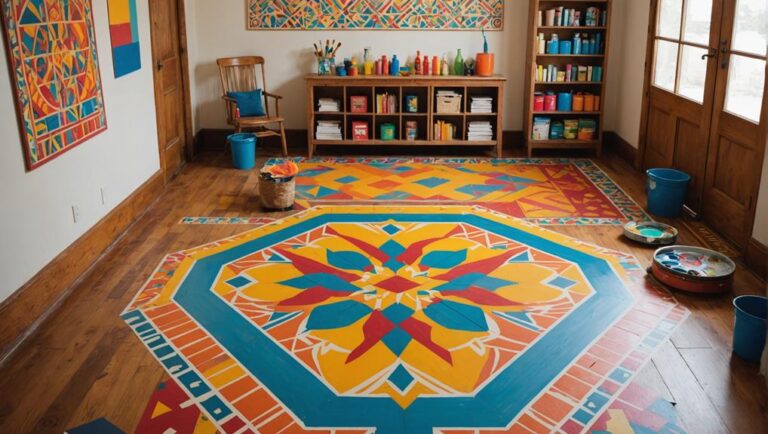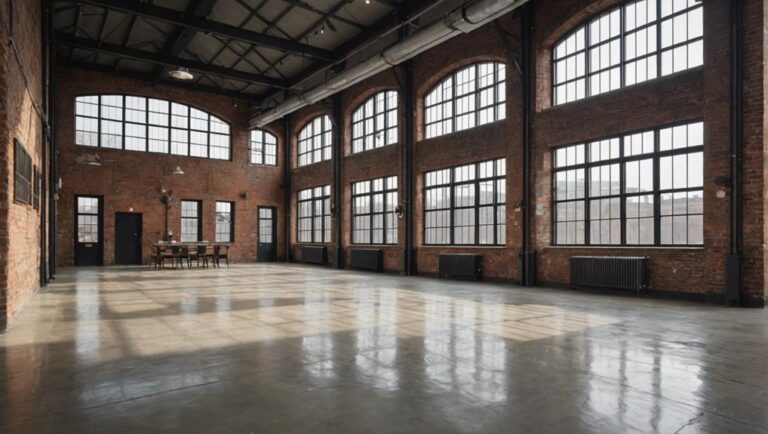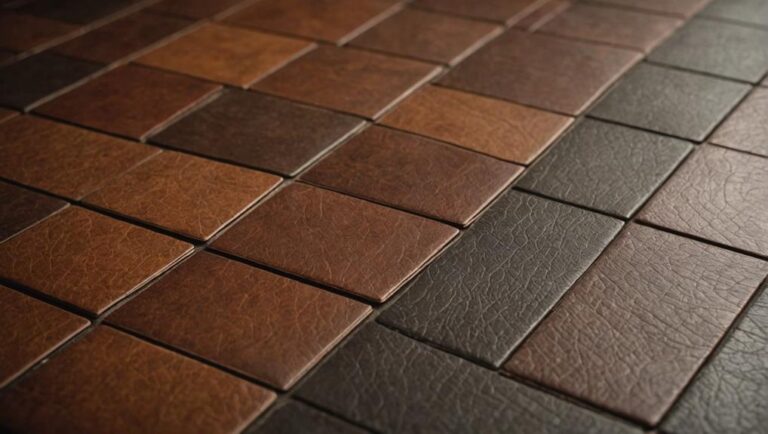You can easily tackle floor scratches and scuffs using a few simple methods. First, identify your flooring type, as each requires different care. For minor scratches, use a polish and a soft cloth, buffing gently in the appropriate direction. Furniture markers work wonders too—just match the color and apply lightly. If you prefer DIY, mix baking soda and water into a paste, let it sit on scratches, then wipe it off. Finally, wax sticks can fill in blemishes effectively. Want more tips on how to keep your floors looking their best? There's plenty more to discover!
Identify the Type of Flooring
Before you can tackle those pesky scratches and scuffs on your floors, it is vital to identify the type of flooring you have. Different flooring materials require different care and maintenance techniques, especially when it comes to scratch prevention. For instance, hardwood floors, while beautiful and warm, can be more susceptible to scratches compared to tile or laminate options.
Take a moment to examine your floors closely. Are they made of hardwood, laminate, tile, or perhaps vinyl? Each of these materials has unique properties. For example, laminate flooring is designed to resist scratching better than traditional hardwood, making it a great option for high-traffic areas. On the other hand, if you have luxury vinyl, it's known for its durability, but it can still be marked if you're not careful.
Once you've identified your flooring material, you'll be better equipped to implement effective scratch prevention strategies. For hardwood, consider using area rugs in high-traffic spots and felt pads under furniture legs. If you have tile or laminate, regular sweeping can help eliminate debris that might cause scratches.
Knowing your flooring type not only aids in selecting the right cleaning products but also guarantees you're using the safest methods to protect your investment. With the right precautions in place, you can keep your floors looking pristine and prolong their life, making your living space both functional and aesthetically pleasing.
Use a Soft Cloth and Polish
Using a soft cloth and polish can make a significant difference in restoring the shine and appearance of your floors. Whether you're dealing with hardwood, laminate, or tile, the right polish techniques can help you tackle those pesky scratches and scuffs. Start by choosing the appropriate polish for your floor type, and prepare to make your floors look brand new again.
Before you begin, consider the cloth materials you'll use. A microfiber cloth is often the best choice, as it's gentle on surfaces and effectively traps dirt and dust. Here's a handy table to guide you on the best polish techniques and cloth materials for different floor types:
| Floor Type | Recommended Polish Techniques | Best Cloth Materials |
|---|---|---|
| Hardwood | Apply in the direction of the grain | Microfiber or cotton |
| Laminate | Use a spray polish lightly | Soft microfiber |
| Tile | Buff with circular motions | Soft terry cloth |
| Vinyl | Apply a thin layer evenly | Non-abrasive sponge |
| Cork | Use a natural oil polish | Soft, lint-free cloth |
Once you've selected your polish and cloth, apply the polish in small sections to avoid over-saturation. Gently buff the area with your cloth in circular motions or along the grain, depending on the surface. This method not only helps to remove scratches but also enhances the overall appearance of your floors, leaving them looking polished and protected.
Apply a DIY Furniture Marker
A DIY furniture marker can be a game changer for quickly fixing scratches and scuffs on your floors. These handy tools are designed to blend seamlessly with your flooring, restoring its original look with minimal effort. You can find furniture markers in various colors, making color matching essential for a successful touch-up.
To start, assess the scratch or scuff you want to fix. Choose a furniture marker that closely matches your floor's color. If you're unsure, it's worth testing the marker on an inconspicuous area first. Once you've found the right shade, gently shake the marker to mix the contents.
Next, clean the area around the scratch with a soft cloth to remove any dust or debris. This step helps guarantee that the marker adheres properly. Carefully apply the marker to the scratch, using light strokes to fill it in. It's best to work slowly, allowing the marker to blend in naturally with your flooring. If the scratch is deep, you might need to apply multiple layers, allowing each layer to dry before adding the next.
Once you're satisfied with the coverage, let the area dry completely. After drying, you can buff it lightly with a soft cloth to enhance the finish. With just a little time and effort, your floors can look as good as new, proving that a DIY furniture marker is a smart, safe solution for minor blemishes.
Try Baking Soda Paste
Baking soda paste is an excellent solution for tackling scratches and scuffs on your floors, and it's something you might already have in your kitchen. This simple, safe cleaning paste can help restore your floor's appearance without harsh chemicals, making it perfect for households with kids or pets.
To make your baking soda paste, combine three parts baking soda with one part water in a small bowl. Mix it until you achieve a thick, spreadable consistency. Once you've got your paste ready, gently apply it to the scratched or scuffed area of your floor using a soft cloth or your fingers. Be careful to avoid excessive pressure, as you wouldn't want to damage the finish even further.
After you've applied the paste, let it sit for about 10 to 15 minutes. This allows the baking soda to work its magic by lifting dirt and grime from the scratch. Once the time is up, take a damp cloth to wipe away the paste gently. Rinse the cloth frequently to guarantee you're not just redistributing the dirt.
Utilize a Wax Stick
If baking soda paste doesn't fully address those stubborn scratches, a wax stick can be your next best option. Wax sticks are an effective and straightforward way to fill in and conceal minor blemishes on your floors. They come in a variety of colors, making color matching a breeze for different flooring types.
To start your wax stick application, first confirm the area is clean and dry. Use a soft cloth to wipe away any dust or debris surrounding the scratch. Then, choose a wax stick that closely matches the color of your floor. Many manufacturers offer color charts to help you find the perfect match. If you're unsure, you can always test a small, inconspicuous area to see how well it blends.
Once you've selected your wax stick, simply rub it over the scratch, pressing gently to fill in the damaged area. After applying, smooth out the wax with a plastic scraper or your finger to confirm it's even and blends seamlessly with the surrounding floor. It's important to avoid using too much pressure, as this can cause further damage.
Consider Professional Repair
While DIY solutions can be effective for minor scratches, there are times when professional repair is the best option for restoring your floors to their original condition. If the damage is extensive, such as deep gouges or large scuff marks, it might be worth considering professional services. These experts have the tools and experience to tackle tougher issues that can't be resolved with simple home remedies.
When you decide to go this route, it's a good idea to get several estimates from different professionals. Repair costs can vary widely based on the type of flooring, the severity of the damage, and your location. Knowing the average costs will help you make informed decisions. Don't forget to ask about warranties or guarantees on their work, which can offer peace of mind.
Another benefit of hiring professionals is the safety aspect. They use specialized equipment and techniques, reducing the risk of further damage to your floors. In addition, they're trained to handle any hazardous materials that may be involved in the repair process, keeping your home safe for you and your family.
Prevent Future Scratches
To keep your floors looking pristine, implementing a few preventive measures can go a long way. One of the most effective strategies for floor protection is to use furniture pads. These little felt or rubber pads can be attached to the legs of your chairs, tables, and other furniture to prevent scratches when they're moved. It's a small investment that can save you from costly repairs down the line.
Another important aspect is furniture arrangement. Try to avoid dragging heavy items across the floor. Instead, lift furniture when moving it, or use sliders to reduce friction. You might also consider rearranging your furniture to create pathways for common activities, which can minimize wear and tear in high-traffic areas.
Regular maintenance can also play a significant role in preventing scratches. Keep an eye on dirt and grit that can accumulate on your floors; these particles can act like sandpaper, causing scuffs over time. A simple routine of sweeping or vacuuming can help keep your floors safe.
Lastly, if you have pets, consider trimming their nails regularly to prevent unintentional scratches. Placing rugs or mats in entryways can also capture dirt and debris before they reach your floors.
Frequently Asked Questions
Can I Use Vinegar to Clean Scratched Floors?
Did you know that about 70% of households use vinegar for cleaning? When it comes to scratched floors, vinegar can be beneficial for scratch removal. Its natural acidity helps lift dirt and grime without harsh chemicals, making it a safe option for most surfaces. Just mix equal parts vinegar and water, apply it gently, and wipe with a soft cloth. Always test in a small area first to guarantee it won't damage your floor.
Will Floor Scratches Affect My Home's Resale Value?
Yes, floor scratches can affect your home's resale value. Potential buyers often consider flooring condition when making offers. If your floors show significant wear and tear, it might raise concerns about overall upkeep. You want to maintain a welcoming environment, as well-kept floors create a positive impression. To maximize your resale impact, consider repairing scratches or refinishing your floors before listing your home. This investment can pay off in the long run.
How Often Should I Polish My Floors?
Think of your floors like a beautiful canvas—regular care keeps them vibrant. For effective floor maintenance, you should polish your floors every three to six months, depending on foot traffic. If your home sees a lot of activity, more frequent polishing can help maintain that shine and protect against wear. Remember, a well-maintained floor not only looks great but also enhances safety by reducing slip hazards. So, stay proactive and enjoy your stunning floors!
Are There Eco-Friendly Solutions for Floor Scratches?
Yes, there are eco-friendly solutions for floor scratches! You can try natural remedies like olive oil and vinegar, which can help reduce the appearance of minor scratches. Mixing these ingredients and applying them gently can nourish the wood while providing a protective layer. For scratch prevention, consider using furniture pads and area rugs to shield your floors from wear and tear. These methods are safe and effective, keeping your home looking great without harmful chemicals!
What Tools Do I Need for DIY Floor Repair?
For DIY floor repair, you'll need a few essential floor repair tools. Start with a putty knife for applying scratch remedies, sandpaper for smoothing rough areas, and a clean cloth for wiping surfaces. Depending on the severity of the damage, consider wood filler or touch-up markers. Don't forget safety goggles and gloves to protect yourself while you work. With these tools, you can effectively tackle those pesky scratches and scuffs!




